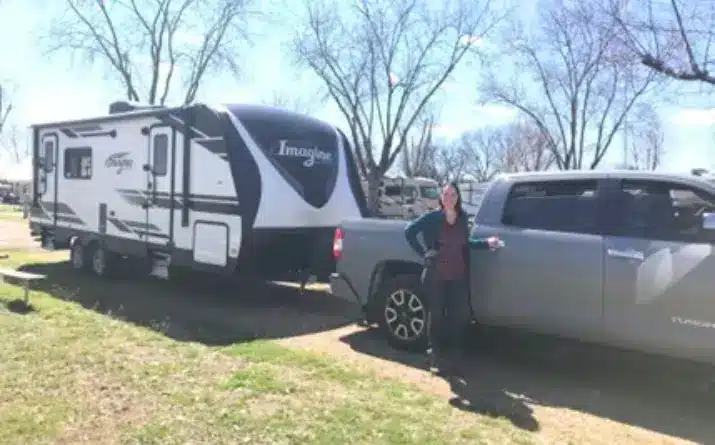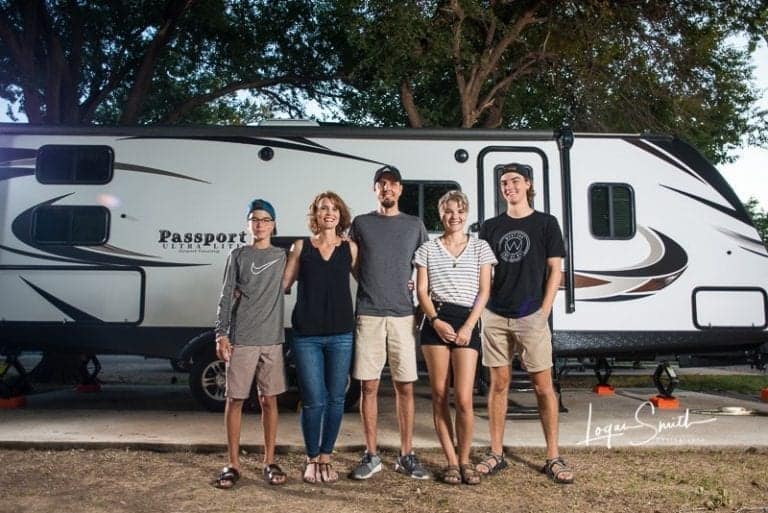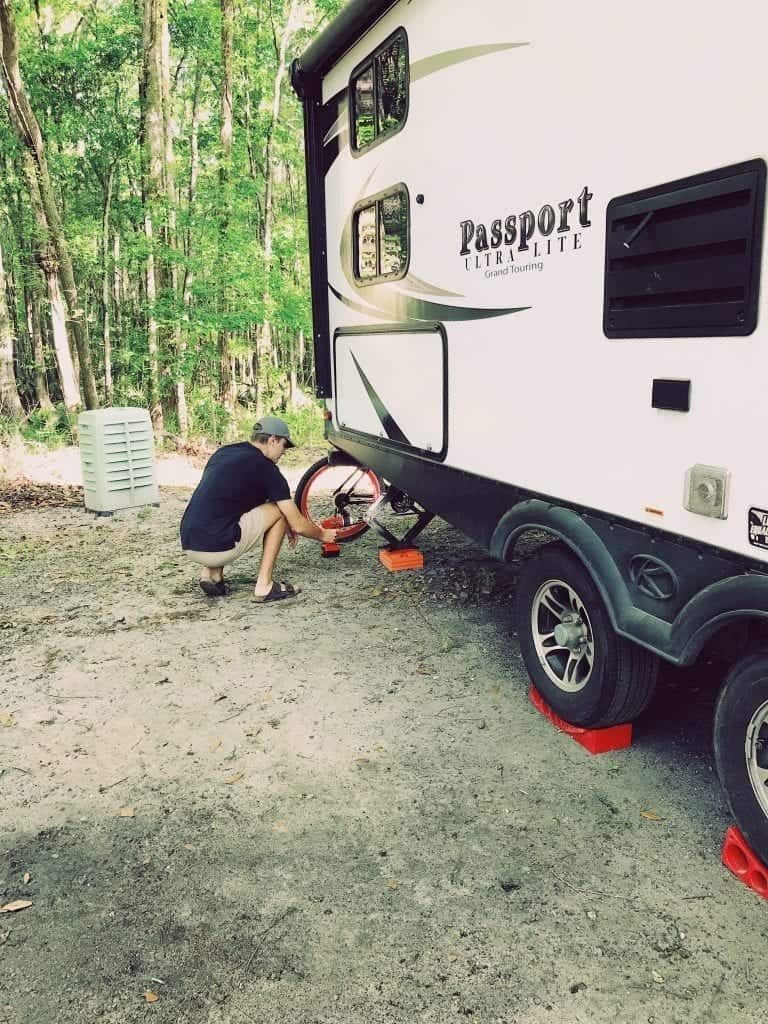Top 5 Reasons I Have a Thousand Trails Membership
For many RV enthusiasts and campers, a Thousand Trails membership is a gateway to exploring the great outdoors with convenience and affordability. For others, it’s a clunky membership to a network of subpar RV parks.
I’ve found that a Thousand Trails membership works well for me and how I travel, but it’s definitely not for everyone.
In this article, I’ll share the top five reasons I decided to join Thousand Trails. I’ll cover everything I like about it—and everything I don’t—so you can make an informed decision about whether Thousand Trails membership is right for you
My Personal Review of a Thousand Trails Membership
Extensive Network of Campgrounds
One perk of being a Thousand Trails member is gaining access to their extensive network of campgrounds.
Your level of access will depend on the type of membership you purchase (more on that below), so it helps to have at least a general idea of where you want to travel over the next year before you start shopping. Some Thousand Trails memberships are regional and others are national (plus British Columbia).

I strongly recommend looking at a map of the Thousand Trails park locations to give you a clear picture of what you’re signing up for. You’ll notice a distinct lack of representation toward the middle of the country, so if you have lots of travel plans in the mountain states and the Midwest, you might be disappointed.
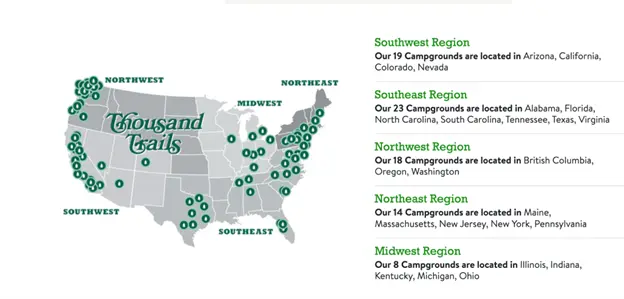
It’s important to note that there are a few different kinds of parks represented on the Thousand Trails map:
- Thousand Trails: These parks are directly “in-network” with Thousand Trails and offer members the longest stays (up to three weeks) and the most options, since every site in these park is dedicated to members.
- Encore/Trails Collection: Think of these as “partner” parks. If you add the Trails Collection to your membership, you can access these parks for up to two weeks at a time, but site availability is more limited.
- “Destination”: I put this park type in quotes because, as far as I can tell, they have nothing to do with Thousand Trails at all. Members don’t get any discounts or perks, and if you find these parks via the Thousand Trails website, you just end up booking directly with the park like any other customer. TL;DR: ignore the light green spots on the map when deciding whether to purchase.
For me, the wide variety of locations is a significant perk. There’s a lot of representation along both coasts, and coastal RV parks tend to be the most expensive. I’m stepping on my next point a bit here, but Thousand Trails is the most cost-effective way I’ve found to travel in places like the Pacific Northwest and Florida, where public lands are a bit trickier to find for boondocking and where hookups are often a must due to heavy rain or heat.
Cost-Effective for Frequent Campers
If you buy a zone pass, you’ll spend a few hundred dollars ($600 at the time of writing) for unlimited use of campgrounds within the Thousand Trails network—those dark green circles on the map.
At the most basic level, you can’t go directly from park to park—you have to be out of the system for seven days before you come back in. But you can still spend weeks at a time camping on your Thousand Trails pass.
As someone who travels full-time and often stays in RV parks, I’ve found the cost savings to be substantial. Paying a single annual fee for unlimited camping can bring your overall expenses way down, as long as you use it.
(That said, there are some drawbacks, which I’ll discuss in the pros and cons section below.)
But if you’re like me and don’t want to boondock 100% of the time, a Thousand Trails membership can save you a lot of money. The parks provide safe and convenient places to dump, fill water, do laundry, and (often) receive packages while you’re on the road. And as I mentioned above, they make expensive coastal destinations like Florida much more affordable, so you can stay in an area longer or budget more for fun activities than you otherwise might.
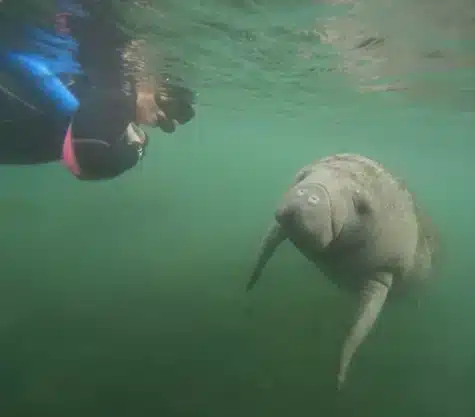
Different Membership Levels
One of the things I like about Thousand Trails is how flexible it can be. They offer different membership levels, each with its own set of perks.
The details change constantly and can get a little complicated, so you’re better off confirming with Thousand Trails directly if you want to dig into the specifics.
But in general, you can buy two types of access:
Zone Pass
This will get you a year of access to campgrounds in a particular region. Thousand Trails has divided the United States and parts of Canada into five regions:

- Southwest (19 campgrounds): Arizona, California, Colorado, Nevada
- Southeast (23 campgrounds): Alabama, Florida, North Carolina, South Carolina, Tennessee, Texas, Virginia
- Northwest (18 campgrounds): British Columbia, Oregon, Washington
- Northeast (14 campgrounds): Maine, Massachusetts, New Jersey, New York, Pennsylvania
- Midwest (8 campgrounds): Illinois, Indiana, Kentucky, Michigan, Ohio
You can add additional regions to your zone pass if you know you’ll be in more than one throughout the year. So, for example, you can buy the Southwest pass and add the Northwest zone to your annual pass at a reduced rate.
You can also add Trails Collection parks to your pass for a flat fee, which is currently $425.
Elite Memberships
You can also buy upgraded membership levels that are much more expensive to purchase (generally $10,000+) but offer lifetime access.
These elite memberships have the highest levels of flexibility. You can go directly from park to park (except Trails Collection parks) and could theoretically camp all year only at Thousand Trails locations.
There are other perks, too, such as cabin rentals, extended stay options, and reduced storage rates. This level of flexibility makes Thousand Trails more adaptable for a wide range of people, but I’d be a bit wary of the higher-tier memberships.
Do the math to ensure they’ll work for you before investing. Yes, they’re lifetime memberships, but you still have to pay an annual fee (the cost of a zone pass) every year to keep them active.
Community
One of the things I like about RV parks is their level of community engagement. You’ll generally find a rec room with organized activities like bingo, ping pong, poker nights, potlucks, and other chances to socialize with fellow campers.
Being part of Thousand Trails also means joining a community of like-minded travelers, which can be a great way to make new friends and share experiences. Because the Thousand Trails network of parks is limited, you’re also reasonably likely to run into the same people more than once, which is a great way to build lasting relationships on the road.


Related Reading: Tips for Finding RV Community on the Road
Amenities
Thousand Trails parks often include amenities like swimming pools, hiking trails, laundry facilities, and recreational activities like mini golf. I don’t like paying a premium for these kinds of things at a standard RV park, which can easily run you $85+ per night if you’re at a “resort,” but I do appreciate the value when it’s rolled into a low annual fee.
As a dog owner, I’ve been happy to find that most Thousand Trails parks include a dog park. That gives my pups a chance to romp with each other and make new friends. In urban areas or locations without public land nearby, it can be difficult to find spots to let your dogs run. In a pinch, even a small dog run at an RV park can feel like a godsend.

Related Reading: Essential Tips to Keep Dogs Safe on a Hike
Pros and Cons of a Thousand Trails Membership
The value of a Thousand Trails membership is different for everyone, and there are certain drawbacks to know about before you commit. Even an annual zone pass (the lowest cost option) is a lot of money to shell out all at once, so do your homework and make sure you know what matters to you before making your decision.
Thousand Trails Membership Pros
Here are the top benefits of having access to a Thousand Trails membership.
Thousand Trails Membership Cons
That said, there are also a few drawbacks to consider.

In Conclusion
Overall, I’m glad I bought my Thousand Trails membership. I’ve saved money, camped in places that would have otherwise been difficult or expensive, and met some wonderful people.
However, it’s important to weigh the pros and cons based on your camping frequency, desired locations, and the type of experiences you enjoy.
Related Reading

Sarah Kuiken has been a full-time solo traveler for 4 years and counting, but she’s been a solo adventurer for decades. She owns her own copywriting business, Flourish Writing, which she operates from the road. Sarah loves to explore state and national parks with her two dogs, Orion and Piper—wherever they’re allowed, of course. When she’s not whipping up web copy for fellow entrepreneurs, she’s probably out hiking or paddle boarding with the dogs in tow. Learn more about her freelance writing business at FlourishWriting.com.



